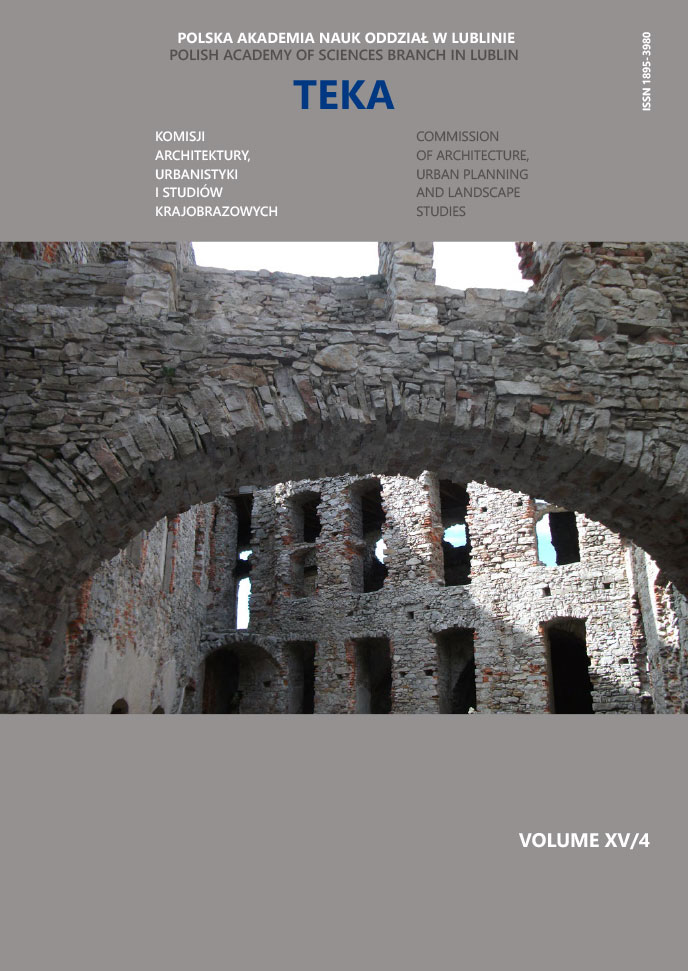Biologically active area in low-rise high-denisty housing development with an example of Bialystok
Article Sidebar
Open full text
Issue Vol. 15 No. 4 (2019)
-
Housing estate greenery in shaping the quality of housing environment on the example of Bialystok
Marta Baum7-13
-
Las Zwierzyniecki as an Element of the Composition of Green Areas in Białystok
Dorota Gawryluk14-22
-
Green areas in Białystok
Jolanta Niedzielko, Agata Łochnicka23-29
-
Social participation in designing urban spaces related to green areas on the example of Białystok
Kamil Rawski30-37
-
Disabled people in housing estates
Kamil Rawski38-45
-
Biologically active area in low-rise high-denisty housing development with an example of Bialystok
Wojciech Matys46-53
Archives
-
Vol. 17 No. 4
2021-12-30 11
-
Vol. 17 No. 3
2021-12-30 9
-
Vol. 17 No. 2
2021-12-30 8
-
Vol. 17 No. 1
2021-12-30 8
-
Vol. 16 No. 4
2020-12-30 11
-
Vol. 16 No. 3
2020-09-30 10
-
Vol. 16 No. 2
2020-06-30 11
-
Vol. 16 No. 1
2020-03-31 10
-
Vol. 15 No. 4
2019-12-30 6
-
Vol. 15 No. 3
2019-10-31 9
-
Vol. 15 No. 2
2019-06-28 12
-
Vol. 15 No. 1
2019-03-29 13
-
Vol. 14 No. 3
2018-10-28 14
-
Vol. 14 No. 2
2018-06-29 14
-
Vol. 14 No. 1
2018-03-30 13
-
Vol. 13 No. 4
2017-12-29 8
-
Vol. 13 No. 3
2017-09-29 9
-
Vol. 13 No. 2
2017-06-30 10
-
Vol. 13 No. 1
2017-03-31 10
Main Article Content
DOI
Authors
Abstract
The biologically active area is one of the most important elements of residential development. Its size is determined by the percentage factor established in local spatial development plans and laws regulations. The publication was set minimum values for this ratio for single-family and multi-family housing, and the outcomes were compared with a new type of housing, currently popular in Poland, low-rise high-density residential development. The studies were done on the example of the city of Bialystok, where there are many buildings of this new type of housing.
Keywords:
References
A collective work edited by Bieganska E., 1953: Arranging green areas (in Polish), State Technical Publisher, Warsaw
A collective work edited by Zwolanowska B., 1970: Small urban dictionary (in Polish), Institute of town planning and architecture, Warsaw
A collective work edited The Society of Polish Town Planners, 2003: Urban planner’s guide (in Polish), Warsaw
Korzeniewski W., 1981: A guide to a housing designer (in Polish), Arkady, Warsaw
Ptaszycka A., 1950: Green spaces in cities (in Polish), People’s Publishing Cooperative, Poznan
Rozanski S., 1959: Construction of the town and its climate (in Polish), Arkady, Warsaw
Saternus P., 2013: Lexicon of urban planning and spatial planning (in Polish), Bel Studio, Warsaw
Seruga W., 1984: Conditions and criteria for forming low-rise high-intensive residential development (in Polish), Cracow University of Technology Publishing House, Krakow
Tolwiński T., 1963: Town planning. Greenery in urban planning (in Polish), PWN, Warsaw
Regulation of the Minister of Infrastructure of April 12, 2002, on the technical requirements to be met by buildings and their location (Journal of Laws No. 75, item 690) as amended (in Polish)
Building Law Act of July 7, 1994 (Journal of Laws No. 89, item 414) as amended (in Polish)
Spatial development plans of Bialystok (no. of plan – City Council Resolution no.): 8-LXIV/642/98, 58-XLVI/526/05, 59-XLVII/553/05, 60-XLVII/554/05, 66-LXI/747/06, 68-LXI/749/06, 69-LXI/751/06, 73-LXII/768/06, 74-LXII/769/06, 79-XII/110/07, 82-XXIX/330/08, 86-XXXIII/399/08, 93-LVI/724/10, 96-VI/36/11, 97-VI/37/11, 98-VII/53/11, 99-VII/54/11, 100-IX/72/11, 101-XI/81/11, 103-XII/95/11, 106-XVIII/176/11, 107-XXII/209/12, 109-XXIII/241/12, 112-XXIX/295/12, 118-XLVIII/540/13, 137-XXV/378/16, 139-XXVI/417/16, 142-XXVII/445/16, 146-XLI/622/17, 149-XLIX/747/18
GSI Białystok, https://gisbialystok.pl
Article Details
Abstract views: 348
License

This work is licensed under a Creative Commons Attribution-ShareAlike 4.0 International License.


